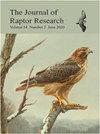Long-term Trends of Autumn-migrating Buteos Around Henrys Lake Flat, Idaho, USA
IF 1.2
4区 生物学
Q2 ORNITHOLOGY
引用次数: 0
Abstract
We conducted an annual late-summer raptor survey along a 53-km route around Henrys Lake Flats, Idaho, from 1994 to 2022, and pooled the resulting data with similar published information collected from 1974 to 1993. A mean of 36 Red-tailed Hawks (Buteo jamaicensis), 13 Ferruginous Hawks (Buteo regalis), and 16 Swainson’s Hawks (Buteo swainsoni) were observed each year along this route. The counts of Ferruginous Hawks declined significantly (P < 0.001) over the combined study period and were almost 10 times lower from 2013–2022 compared to 1974–1983. The counts of Red-tailed Hawks also declined significantly (P = 0.04), whereas no significant variation was evident for Swainson’s Hawks over the combined 49-yr study period. Summer precipitation levels and hawk numbers were not correlated. The observed numbers of Ferruginous Hawks and Red-tailed Hawks were correlated throughout the study period, suggesting similar responses to local environmental and/or land-use factors. Obvious changes in the study area during the corresponding 49 yr include conversion of some pastures to center-pivot-irrigated agriculture and a substantial expansion of all-terrain vehicle trails and recreational activity. Because 88% of Ferruginous Hawks breeding in the Columbia Basin funnel through the upper Snake River Plain and adjacent areas on their way to post-breeding ranges in the Great Plains, expanded surveys in these areas in late August/early September could effectively monitor this intermountain population.美国爱达荷州亨利斯湖平地附近秋季迁徙的疣鼻天鹅的长期趋势
从 1994 年到 2022 年,我们每年都会沿着爱达荷州亨利斯湖平地周围 53 公里的路线进行夏末猛禽调查,并将所得数据与 1974 年到 1993 年收集的类似公开信息进行汇总。每年在这条路线上平均观察到36只红尾鹰(Buteo jamaicensis)、13只铁皮鹰(Buteo regalis)和16只斯温森鹰(Buteo swainsoni)。在整个研究期间,铁斑鹰的数量显著下降(P < 0.001),2013-2022 年期间铁斑鹰的数量几乎是 1974-1983 年期间的 10 倍。红尾鹰的数量也明显下降(P = 0.04),而斯温森鹰的数量在49年的综合研究期间没有明显变化。夏季降水量与鹰的数量没有相关性。在整个研究期间,观察到的铁皮鹰和红尾鹰的数量是相关的,这表明它们对当地环境和/或土地利用因素的反应是相似的。在相应的 49 年间,研究区域发生了明显的变化,包括一些牧场转为中心枢轴灌溉农业,以及全地形车道和娱乐活动的大幅扩展。由于在哥伦比亚盆地繁殖的88%的铁斑鹰在前往大平原的繁殖地途中会经过蛇河上游平原及邻近地区,因此在8月底/9月初扩大对这些地区的调查可以有效地监测这一山间种群。
本文章由计算机程序翻译,如有差异,请以英文原文为准。
求助全文
约1分钟内获得全文
求助全文
来源期刊

Journal of Raptor Research
生物-鸟类学
CiteScore
2.30
自引率
17.60%
发文量
61
审稿时长
>12 weeks
期刊介绍:
The Journal of Raptor Research (JRR) is an international scientific journal dedicated entirely to the dissemination of information about birds of prey. Established in 1967, JRR has published peer-reviewed research on raptor ecology, behavior, life history, conservation, and techniques. JRR is available quarterly to members in electronic and paper format.
 求助内容:
求助内容: 应助结果提醒方式:
应助结果提醒方式:


